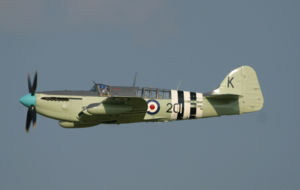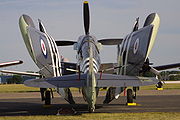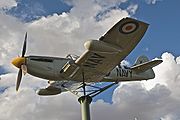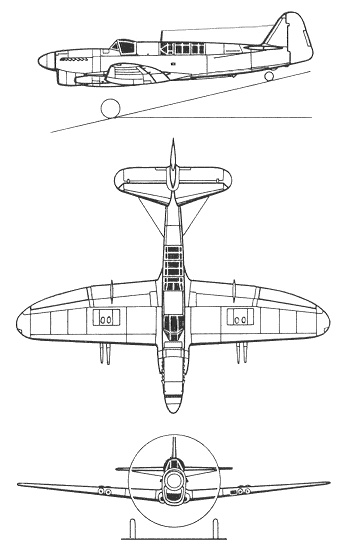Fairey Firefly Video - World War II Film
More Fairey Firefly Videos 1 2 3 4 - Fairey Firefly Pictures
|
|
|
|
 Picture:
Fairey Firefly AS.Mk 6 Picture:
Fairey Firefly AS.Mk 6 |
 Picture:
Firefly with wings folded, Oshkosh, 2002
Picture:
Firefly with wings folded, Oshkosh, 2002
Role - Carrier Fighter
Manufacturer - Fairey Aviation Company, Ltd.
First flight - 22 December 1941
Introduced - 1943
Retired - 1958 (Fleet Air Arm)
Primary user - Fleet Air Arm
Produced - 1941-1955
Number built - 1,702
The Fairey Firefly was a British Second World War-era carrier-borne fighter aircraft of the Fleet Air Arm. It was superior in performance and firepower to its predecessor, the Fulmar, but did not enter operational service until towards the end of the war. It remained a mainstay of the FAA until the mid-1950s.
Design and development
 Picture:
Firefly on display at Griffith
Picture:
Firefly on display at Griffith
The Firefly was designed by H.E. Chaplin at Fairey Aviation in 1940; in June 1940, the Admiralty ordered 200 aircraft to meet Specification N.5/40. The prototype of the Mk I Firefly flew on 22 December 1941.[1] Although it was 4,000 lb (1,810 kg) heavier than the Fulmar (due largely to its armament of two 20 mm cannon in each wing), the Firefly was 40 mph (60 km/h) faster due to improved aerodynamics and a more powerful engine, the 1,735 hp (1,294 kW) Rolls-Royce Griffon IIB.
The Firefly is a low-wing cantilever monoplane with oval-section metal semi-monocoque fuselage and conventional tail unit with forward-placed tailplane. Powered by a Rolls-Royce Griffon liquid-cooled piston engine with a three-blade airscrew. The Firefly had retractable main landing gear and tail wheel, with the hydraulically-operated main landing gear retracting inwards into the underside of the wing centre-section. The aircraft also had a retractable arrester hook under the rear fuselage. The pilot's cockpit was over the leading edge of the wing and the observer/radio-operator/navigator aft of the wing trailing edge. Both crew had separate jettisonable canopies. The all metal wing could be folded manually, with the wings along the sides of the fuselage. When in the flying position the wings were hydraulically locked.[2]
Operational service
The primary variant of the aircraft used during the Second World War was the Mk I, which was used in all theatres of operation. In March 1943, the first Firefly Mk Is were delivered but they did not enter operational service until July 1944 when they equipped No. 1770 Squadron aboard HMS Indefatigable. The first operations were in Europe where Fireflies made armed reconnaissance flights and anti-shipping strikes along the Norwegian coast. Fireflies also provided air cover during strikes on the German battleship Tirpitz in 1944.
Throughout its operational career, the Firefly took on increasingly more demanding roles from fighter to anti-submarine warfare stationed mainly with the British Pacific Fleet in the Far East and Pacific theatres. Fireflies carried out attacks on oil refineries and airfields and gained renown when they became the first British-designed and -built aircraft to overfly Tokyo.[3]
After the Second World War, the Firefly remained in service in the UK, which also supplied the aircraft to Canada, Australia, Denmark, the Netherlands and Thailand. The Royal Canadian Navy employed 65 Fireflies of the Mk AS 5 type onboard its own aircraft carriers between 1946 and 1954. It also had some Mk I Fireflies, and sold several of these to Ethiopia in the early 1950s. British and Australian Fireflies carried out anti-shipping patrols and ground strikes off various aircraft carriers in the Korean War as well as serving in the ground-attack role in the Malaya. The Firefly's FAA frontline career ended with the introduction of the Gannet.
Variants
Firefly I / FR.I
-Two variants of the Mk I Firefly were built; 429 "fighter" Firefly F Mk Is, built by Fairey and General Aircraft Ltd, and 376 "fighter/reconnaissance" Firefly
FR Mk Is (which were fitted with the ASH detection radar). The last 334 Mk Is built were upgraded with the 1,765 hp (1,316 kW) Griffon XII engine.
Firefly F.Mk 1A
Firefly with wings folded, Oshkosh, 2002.
Firefly NF.Mk II
-Only 37 Mk II Fireflies were built, all of which were night fighter Firefly NF Mk IIs. They had a slightly longer fuselage than the Mk I and had modifications
to house their airborne interception (AI) radar.
Firefly NF.Mk I
-The NF.II was superseded by the Firefly NF Mk I "night fighter" variant.
Firefly T.Mk 1
-Two-seat pilot training aircraft. Post-war conversion of the Firefly Mk I.
Firefly T.Mk 2
-Armed operational training aircraft. Post-war conversion of the Firefly Mk I.
Firefly T.Mk 3
-Used for Anti-submarine warfare training. Postwar conversion of the Firefly Mk I.
Firefly TT.Mk I
-Postwar, a small number of Firefly Mk Is were converted into target tug aircraft.
Firefly Mk III
-A Firefly Mk III was proposed, based on the Griffon 61 engine, but never entered production.
Firefly Mk IV
-The Firefly Mk IV was equipped with the 2,330 hp (1,740 kW) Griffon 72 engine and first flew in 1944, but did not enter service until after the end
of the war.
Firefly FR.Mk 4
-Fighter-reconnaissance version based on the Firefly Mk IV.
Firefly Mk 5
Firefly NF.Mk 5
-Night fighter version based on the Firefly Mk 5.
Firefly RF.Mk 5
-Reconnaissance fighter version based on the Firefly Mk 5.
Firefly AS.Mk 5
-The later Firefly AS.Mk 5 was an anti-submarine aircraft, which carried American sonobuoys and equipment.
Firefly Mk 6
Firefly AS.Mk 6
-The Fairefly AS.Mk 6 was an anti-submarine aircraft, which carried British equipment.
Firefly TT.Mk 4/5/6
-Small numbers of AS.4/5/6s were converted into target tug aircraft.
Firefly AS.Mk 7
-The Firefly AS.Mk 7 was an anti-submarine aircraft, powered by a Rolls-Royce Griffin 59 piston engine.
Firefly T.Mk 7
-The Firefly T.Mk 7 was an interim ASW training aircraft.
Firefly U.Mk 8
-The Firefly U.Mk 8 was a target drone aircraft; 34 Firefly T.7s were diverted on the production line for completion as target drones.
Firefly U.Mk 9
-The Firefly U.Mk 9 was a target drone aircraft; 40 existing Firefly Mk AS.4 and AS.5 aircraft were converted to this role.
Operators
Wartime
United Kingdom
- Fleet Air Arm
Post War
Australia
- Royal Australian Navy Fleet Air Arm
-- No. 723 Squadron RAN
-- No. 724 Squadron RAN
-- No. 725 Squadron RAN
-- No. 816 Squadron RAN
-- No. 817 Squadron RAN
-- No. 851 Squadron RAN
Canada
- Royal Canadian Navy
Denmark
- Royal Danish Air Force
Ethiopia
- Ethiopian Air Force
Netherlands
- Dutch Naval Aviation Service
Sweden
- Svensk Flygtjanst AB at Bromma operated several TT.1 aircraft between 1949 and 1964.[4]
Thailand
- Royal Thai Air Force operated Fireflies between 1952 and 1966.[5]
United Kingdom
- Fleet Air Arm operated Fireflies till 1956 when aircraft was replaced by the Fairey Gannet.
Survivors
There are approximately 24 Fairey Fireflies surviving worldwide, including three airworthy examples and at least one other being restored to flying condition. The Fleet Air Arm Museum possesses two Fireflies, the latest acquisition arriving in 2000 from the Imperial War Museum Duxford. Firefly WB271 was destroyed in July 2003 during an aerobatic air display at the Imperial War Museum in Duxford, Cambridgeshire - Europe's largest display of vintage war planes. There are three airworthy Fireflies at present: the Canadian Warplane Heritage Museum (Canada) Firefly AS 6 WH632, which was damaged in a crash and has since been restored to flying condition (painted as an RCN Firefly AS 5), AS 6s WD826 at the Royal Australian Navy Historic Flight, NAS Nowra NSW (Australia) and WB518, another former RAN machine, in the USA. The latter was one of the first ten Mk 6s built, but retained the earlier Mk 5 fuselage; originally delivered to the Royal Australian Navy's 817 Squadron, it served in 816 Squadron before being retired and ending up as a memorial on a pole in Griffith, New South Wales, Australia. Purchased by American Eddie Kurdziel, a former U.S. Navy pilot and Northwest Airlines captain, after an extensive restoration WB518 made its first public appearance at the 2002 Oshkosh event.
Other survivors include: in Australia, Firefly AS 6 WD827 which was first owned by the Australian Air League, Blacktown, New South Wales, and now on display in the Moorabin Air Museum, Melbourne, Victoria; and AS 6 "WD828" is displayed on a pole at Griffith, New South Wales (painted as "WB518", which originally was displayed there); and AS 6 WJ109 is on display at Australia's Museum of Flight, Nowra, NSW. Another ex-Australian Flying, AS 6 WD833, is owned by Henry "Butch" Schroeder who moved the aircraft to Danville, Illinois USA for restoration. The present whereabouts of this aircraft are unclear.
A Firefly is on static display outside the Returned and Services League (RSL) club in Griffith, New South Wales, Australia.
As well as the Canadian Warplane Heritage's ex-Australian Firefly, two other Fireflies are known to exist in Canada: one is at the Canadian Aviation Museum in Ottawa and another is being restored at the Shearwater Aviation Museum at Eastern Passage (near Dartmouth), Nova Scotia. Both are Mk I models that served in the Canadian Navy from 1946 to 1954, after which they were sold to the Ethiopian Air Force. Following their discovery in the Ethiopian desert in 1993, they were repatriated to Canada.
Specifications (Mk I)
General characteristics
 - Crew: Two (pilot & observer)
- Crew: Two (pilot & observer)
- Length: 37 ft 7¼ in (11.46 m)
- Wingspan: 44 ft 6 in (13.57 m)
- Height: 13 ft 7 in (4.14 m)
- Wing area: 328 ft² (30.5 m²)
- Empty weight: 9,750 lb (4,432 kg)
- Loaded weight: 14,020 lb (6,373 kg)
- Powerplant: 1× Rolls-Royce Griffon IIB liquid-cooled V12 engine, 1,730 hp (1,290 kW)
Performance
- Maximum speed: 316 mph (275 kn, 509 km/h) at 14,000 ft (4,300 m)
- Range: 1,300 mi (1,130 nmi, 2,090 km)
- Service ceiling: 28,000 ft (8,530 m)
- Climb to 10,000 ft (3,050 m): 5 min 45 sec
Armament
- Guns: 4 × 20 mm Hispano-Suiza HS.404 cannons
- Rockets: 8 × RP-3 "60 lb" rockets or
- Bombs: 2 × 1,000 lb (454 kg) bomb
Specifications (Mk IV)
General characteristics
- Crew: Two (pilot & observer)
- Length: 38 ft 9 in (11.8 m)
- Wingspan: 41 ft 2 in (12.55 m)
- Height: 14 ft 4 in (4.37 m)
- Wing area: 330 ft² (30.66 m²)
- Empty weight: 9,859 lb (4,472 kg)
- Loaded weight: 13,200 lb (6,000 kg)
- Max takeoff weight: 16,096 lb (7,301 kg)
- Powerplant: 1× Rolls-Royce Griffon 74 liquid-cooled V12 engine, 2,245 hp (1,674 kW)
Performance
- Maximum speed: 386 mph at 14,000 ft (618 km/h at 4,300 m)
- Range: 1,300 mi (1,722 km) with auxiliary tanks
- Service ceiling: 31,900 ft (9,723 m)
- Rate of climb: 1,900 ft/min (9.7 m/s)
- Wing loading: 40 lb/ft² (195.7 kg/m²)
Armament
- Guns: 4 × 20 mm Hispano-Suiza HS.404 cannons
- Rockets: 16 × RP-3 "60 lb" rockets
- Bombs: 2 × 1,000 lb (454 kg) bomb under wings
Comparable aircraft
- Fairey Fulmar
- Fairey Gannet
References
Notes
1. Thetford 1978, p.164.
2. Bridgman, Leonard. Jane's Fighting Aircraft of World War II. New York: Crescent Books, 1988. ISBN 0-517-67964-7.
3. Thetford 1978, p.168.
4. Firefly TT.1 DT989 entry at the Warbirdregistry.org website
5. Firefly FB.1 MB410 entry at the Warbirdregistry.org website
6. Thetford 1978, p.171.
Bibliography
- Brown, Eric, CBE, DCS, AFC, RN.; Green William and Swanborough, Gordon. "Fairey Firefly". Wings of the Navy, Flying Allied Carrier Aircraft
of World War Two. London: Jane's Publishing Company, 1980, p. 145–157. ISBN 0-7106-0002-X.
- Bussy, Geoffrey. Fairey Firefly: F.Mk.1 to U.Mk.9 (Warpaint Series 28). Milton Keynes, United Kingdom: Hall Park Books Ltd., 2001. ISBN 0-9999-00284.
- Harrison, William A. Fairey Firefly - The Operational Record. Shrewsbury, UK: Airlife, 1992. ISBN 1-85310-196-6.
- Harrison, William A. Fairey Firefly in Action (Aircraft number 200). Carrollton, Texas: Squadron/Signal Publications Inc., 2006. ISBN 0-89747-501-1.
- Taylor, H.A. Fairey Aircraft since 1915. London:Putnam, 1974. ISBN 0-370-00065-x.
- Thetford, Owen. British Naval Aircraft since 1912. London: Putnam, Fourth edition, 1978. ISBN 0 370 30021 1.
- Thomas, Graham. Furies and Fireflies over Korea: The Story of the Men and Machines of the Fleet Air Arm, RAF and Commonwealth Who Defended South Korea
1950-1953. London: Grub Street, 2004. ISBN 1-90401-004-0.
Living Warbirds: The best warbirds DVD series.
Source: WikiPedia